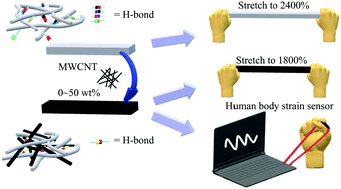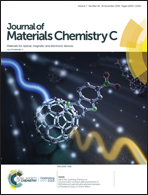Highly-stretchable, self-healable random copolymers for loading large amounts of multiwall carbon nanotubes (MWCNTs) for the preparation of stretchable and healable electric sensors†
Abstract
Development of electric sensors from polymers/carbon conductors has drawn increasing research attention and with this in mind, we prepared stretchable and healable random copolymers M1 and M2, from radical polymerization of methyl methacrylate (MMA), methacrylic acid (MAA) and oligo(ethylene glycol) methyl ether methacrylate (OEGMA) monomers, for homogeneously blending large amounts (up to equivalent weight) of MWCNTs for the preparation of healable and stretchable conductive nanocomposite sensors with keen responses toward minute, medium and large strain deformations. With the reversible hydrogen bond (H bond) interactions between the inherent pendant groups, random copolymers are healable and highly-stretchable (with a fracture strain σf up to 2446%) and after being mixed with different amounts of MWCNTx, the resulting composite films are highly conductive (with conductivity up to 2.06 × 103 S m−1) and are healable and stretchable (σf up to 1890%). The suitability of the composite films as electric sensors for strain deformations was evaluated and discussed in this study.



 Please wait while we load your content...
Please wait while we load your content...